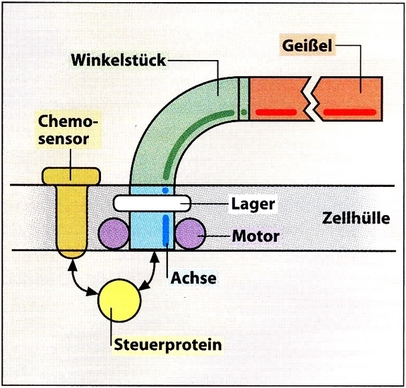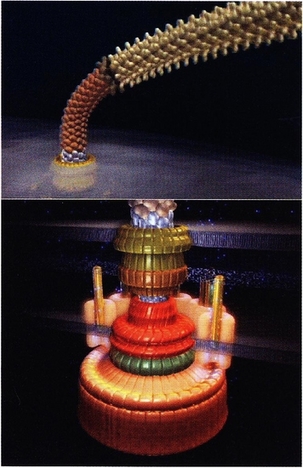 |
 |
 |
 |
 |
 |
 |
 |
|
 |
 |
 |
03 Irreducible complex systems
|
| Menu | back |
An irreducible complex system is what one calls an arrangement of individual components, every one of which must be present for the overall system to function. For a car to run, it needs, at the very least, an engine, a clutch, four wheels, and a steering wheel. The idea that a primeval car in an early development stage, could have been driven without an engine or a clutch or without wheels is just as unthinkable as the idea that the biodiversity of life on Earth could have come about one step at a time.
All living creatures contain irreducible complex systems. If a single element of such a system is removed, either the whole system collapses or the entire function of the system comes to a standstill. Such systems cannot be set up one step at a time, as, without a certain minimum of components, they are incapable of functioning or living.
Charles Darwin has already addressed this problem. In his book The Origin of Species he writes, If it could be demonstrated that any complex organ existed, which could not possibly have been formed by numerous, successive, slight modifications, my theory would absolutely break down.
In this respect, Darwin was still very level-headed. If he had known what we know today, then he would probably not have published his book. Indeed, in the last 150 years, the theory of evolution has become such a powerful myth, that many experts can no longer see the forest for the trees.
Even the simplest cell requires a special casing, mechanisms for controlling its metabolism, mechanisms for reading, writing and duplicating DNA, etc.
Further examples include human organs such as the eyes, the ear, or the brain; knee joints; the flying apparatus of birds, bats, and insects; numerous symbiotic life partnerships; the immune system; photosynthesis; intracellular protein transport, etc. (1).
The supply of individual components is also part of the production of these systems. They must be compatible with one another and be capable, from the very start, of performing their function correctly. The biochemist, Michael J. Behe states that, in the past seventeen years, not a single professional journal has reported anything concerning the intermediate forms necessary during the development of complex bimolecular structures (2). That should give pause for thought. Below are three examples of irreducible complex systems.
The bacteria motor (3):
|

Bacterium motor, diagram and 3D model:
The most simple bacterium motor requires a chemical sensor, a control protein, an axis, an elbow, a flagellum, a motor en a bearing. The engine is in the outer membrane, the cell wall and cytoplasmic membrane anchored. Using a coupling the bacterium can stand still, move forward or move backward.
|
 |
Certain bacteria are capable, with the assistance of a motor, of moving around. The rotor of this motor is connected to a whip, which can be made to turn, as a result of which the bacterium receives an impetus. This mechanism is made up of at least nine different individual parts, which must all be correctly assembled for it to function. That such a mechanism should develop one step at a time, with each individual intermediary stage bringing with it a practical survival benefit, is inconceivable. The numerous preliminary stages would not merely perform the function of movement less effectively, but rather not at all.
Metamorphosis:
The butterfly begins its life, just like flies, bees and beetles, in an egg out of which a caterpillar emerges. This caterpillar is preoccupied for the most part with eating. It grows rapidly and sheds its skin several times. Finally, an initial transformation from caterpillar into chrysalis takes place. In the chrysalis, a new creature comes into existence with completely new organs: the butterfly.
This transformation, known as metamorphosis, from caterpillar to chrysalis and then to butterfly, produces a irreducible complex system. Metamorphoses also occur in various different animal phyla, amphibians, coelenterates and others.
Metamorphoses and change of host:
Parasitic flatworms, such as the Lancet liver fluke, are known to have complicated transformation processes with several intermediate stages and host changes. Development cycles of this kind cannot have evolved via small development steps. It always needs all the chain links of development. If one is missing, the creature dies.
These 04 | Menu |
| back |
(1) Michael J. Behe, Darwin´s black box: The Biochemical Challenge to Evolution, The Free Press, New York, 1996, deutsche Übersetzung: Resch-Verlag, 2007, pages 87225.
(2) Michael J. Behe, Nicht reduzierbare komplexe Systeme, factum Juli/August 1998, pages 3239.
(3) Michael J. Behe, Darwins Black Box, Resch-Verlag, 2007, pages 118119.
|
(Image "Bacterium motor, diagram and 3D model") Junker und Scherer, Evolution, ein kritisches Lehrbuch, Weyel, 2006, pages 155 159.
|
| |
Comment this Site!
|
 |
 |
 |
 |
|

